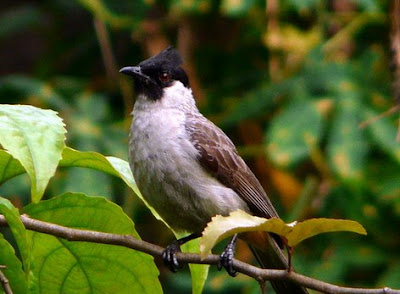Kutilang (Pycnonotus aurigaster) is a local bird that is still underestimated by some kicaumania. In some neighboring countries such as Thailand, Malaysia, and Singapore, the kutilang's fame (especially the crested crown) is equivalent to other chirping birds, even the participants in the finery classes are sometimes more numerous than other classes such as stone magpie (check the article here). Until now there are two opinions about the future of finches in Indonesia.
In the article Lifting the birds of finches, many comments are preferable if the finches are left free to roam the wild. If contested, feared his fate will be the same as the pleci whose population in the wild increasingly thinning.
But, on the other hand, this bird is yet to be captured also by the decoys, sold in the bird market at very cheap prices. If it can be upgraded, included in the race, coupled with breeding efforts like in Thailand and Malaysia, the story may be different.
During this time, many bird enthusiasts consider the sound of a kutilang as a dead voice, which is not good for other chirping birds at home. Yet not all components of the voice of the kutilang including the sound of death. The sound of a finches' thrashing, for example, does not include a dead sound. Including the dead sounds on the component of the sound of a kutilang is "tilung ... tilung ...", because it can reduce the points for the termaster bird when competing. Please see also the article Fussing of finches is voiced green cucak.
In addition, if we want to treat it well and consistently, the original kutilang kutilang considered dead sounds can be lost, replaced by the sounds of other birds masterannya results. Because the kutilang clever imitate the sound of other birds, as well as adaptable and quickly benign. Some kicaumania have told me how kutilangnya in the house diligent sound, and can melagukan most of the master bird material.
The main requirement that a kutilang does not often emit the original sound is to take care of it since the puppies / lolohan, or get it in a condition that is benign. Because the finches are still tame flies, let alone still wild, will still make the original sound.
In the bird market, the price of finery lolohan about Rp 15.000 - Rp 25.000 per head. If you take care of him into adulthood, interspersed with pemasteran, kutilang will make a sound chirp masternya results and will forget the original sound that is considered dead voice by some kicaumania.
Treatment of Luties of Luties
The feed used when overflowing the kutilang puppies is voer and banana. Different feeds of this type may be given alternately during their untying periods.
Giving voer can be done gradually, In the early stages, voer mixed with clean water and stirred until thickened. To keep her condition fit, and to ensure the adequacy of vitamins, you can add BirdVit to the dough.
Bananas are also given gradually. Initially, the banana was softened and mixed a little water so it becomes porridge. Provision of banana porridge is done after the kutilang puppies eat voer batter. After the birds can feed themselves, then provided voer without water and whole bananas, with extra fooding (EF) in the form of a cricket stomach.
Once the puppies can fly, and start practicing chirping, that's when you memasternya with other birds. Pemasteran since puppies much more effective than you get a natural wild capture kutilang that is still wild. If it is a dimaster since the seedling, then the original sound will disappear after the adult bird.
In addition to the usual kutilang (Pycnonotus aurigaster), there are two close relatives who also have the title of finches, the yellow mas / cucak yoke (Pycnonotus melanicterus) and kutilang silk / cucak kurincang (Pycnonotus atriceps). Both species are widely preserved as master birds. Even in Bangka-Belitung, cucak kurincang or called locals as a cep cep cep already contested and have a special class that many devotees.
Yellow lashes or golden kut
Kutilang mas / yellow cucak has a spreading area covering India, China's territory, and Southeast Asia including Peninsular Malaysia and Indonesia.
In our country, mas kutilang many found in Great Sunda (Sumatra, Kalimantan, Java) and Bali. This species has a resemblance to a silk / talc knee. But the yellow cucak feathers are longer, the stomach is yellow, and the eyes are white. While the color of fur cucak kurincang yellow olive.
The sound of a golden kutter is monotonous, but his voice can be "captured" by other birds such as stone magpie, so it can be mastered for a stone magpie or as an angler for MB to sound.
The kutilang mas treatment is not much different from the usual finches and silk kutilang. Feed that can be given include voer, varied fruits, and small insects such as crickets and hongkong caterpillars.


EmoticonEmoticon